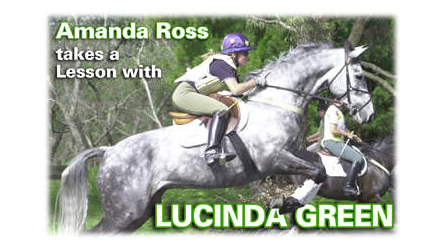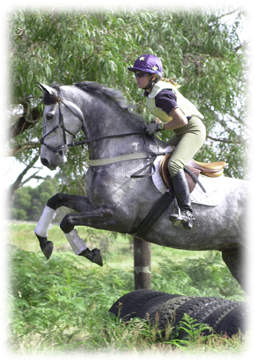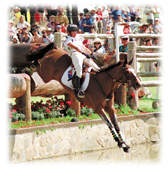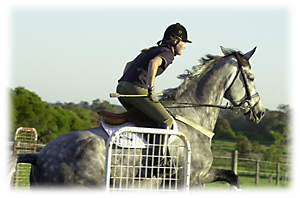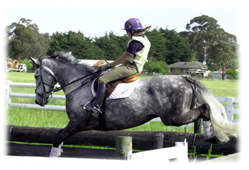Lucinda Green has long been the doyenne of cross country riders, and super tough jockeys like Matt Ryan have consciously modelled their cross country style on Lucinda’s. Sixteen year old Lucinda Prior-Palmer burst on the eventing world, riding Be Fair, three years later the pair won Badminton! Lucinda went on to win a total of six Badmintons on six different horses, and a World Championship in 1982.
These days, Lucinda is only competing for fun, enough to keep her hand in, enough to keep her in touch with the expanding ranks of her pupils all over the world. She is in great demand as a television commentator, and the author of many books on her horses, and the sport of eventing.
We are lucky indeed that Lucinda Green makes regular visits to Australia, and is always happy to help our riders.
Lucinda’s cross country philosophy
It seems to me that for a long time you have been a voice in the wilderness, while many instructors were working on perfect position, perfect stride, you always taught your students to ride ugly lines, and get out of less than wonderful situations?
“I have always felt that you want to give your horse a chance to work his way out of trouble, there are always going to moments when you are in trouble, no matter how brilliant you are, and no matter how well you see your stride. I never had a very good eye for a stride, so I always wanted my horse to learn to get me out of trouble.”
“The best part of the people I teach don’t have a particularly good eye, and even if they do, I don’t want them to use it. I want them to give their horse a chance to get in, and if necessary, get out of trouble. When the horse realises that he is not going to be dictated to, no one is going to tell him exactly where he is going to take off, so his whole mind starts to focus on to the fence and how to negotiate it. It is that attitude that I would rather come forward with, I want my horse to learn to use the best of his ability, and I don’t think he’ll learn to do that if he is constantly waiting for me to tell him when to take off. It is as simple as that.”
“I have no problem with people seeing strides, if you see it, go for it – but what I want people to learn is, how to deal with situations where they see nothing. And that is basically to sit up, balance, and keep your leg on. It is no good throwing your weight forward and praying the horse will take off, because then you wreck their balance, you wreck their impulsion. If you throw your weight forward they find it very difficult to take off. My feeling is that you stay absolutely in the centre of their balance, or just slightly behind it, and you just keep your leg on.”
“There are two things that I want to get through to people. One is to allow the horse to look after you, rather than you looking after him. The second is to make sure that he can see where he is going, and I feel that more and more strongly as the fences become more difficult and complicated. The horse has got to have time to see the problem ahead of him, and work out, what it is. So often you have horses coming into a fence, curled up on the bit obediently, but some horses can only see a fence if they have their head up high, others can only jump really well when their head is down. So I do want riders to, as they study their line, also to check that the horse is looking where he is going, not all coiled up and unable to see.”
Your exercise where you get the riders to pretend the first fence in the arena is a big drop, and to slip their reins and ride the next few fences on the buckle – that is very different from that American equitation approach that says you have to ride every fence perfectly…
“It happens, however good you are, you are, at times, going to be on the buckle, particularly as the fences get big, and sometimes it happens when you least want it to happen, and you’ve got to be able to steer your horse through the next series of fences without having a chance to shorten your reins up. A bit of practice never goes astray – pretend the first element of an awkward line is a drop, then take up the slack as best you can without actually shortening the reins again, and get to the end of the line using your legs and your taken up slack to steer. I want people to feel comfortable with that, instead of feeling, oh my goodness this is ugly I shouldn’t be here. If they get into that situation cross country, I want them to say, oh I’ve practiced this, I can do it. I haven’t got time to shorten my reins, it needs to be an instinctive reaction when things go wrong. Take up the slack by widening your hands, keep your legs on, keep sitting back and get to the other side of your problem.”
“As a teacher, I think you are constantly learning. If anything I have become more keen, that riders should be less obsessed by strides. It is dangerous territory this, because I know the Australian coach, Wayne Roycroft, totally disagrees with my feeling that you don’t need to see a stride and that balance and power are enough. No matter how brilliant you are you don’t always get the right stride.”
“I don’t want to start a public fight with Wayne Roycroft, he’s a very good friend of mine, and he has just coached three gold medal teams in a row. He doesn’t coach many lower level competitors, and maybe he would say he would teach the lower levels the same as me. I feel if you teach the lower levels to worry about strides, you’ll lose the flair, you’ll get them picking and punching.”
“I just want them to get the right spot for that type of fence, to get the horse balanced, which means the horse is not flying about on the forehand. I want them to get the horse focussed on a fence and keep the engine coming, to keep riding and let the horse sort it out. I don’t think you can get a better fundamental than that. If you go on through the stages, and you come to the finesse of advanced event riding, yes it is great if you have a really good eye for a stride, but if you have trained your horse all the way through like this, he is so good at seeing his own stride that it doesn’t matter. He hasn’t had to worry about being fired off when you see a stride – he is used to being balanced, with his engine under him, and he has worked out how and where to put in the short ones.”
“There is no doubt as you get to the bigger fences it is easier to ride them because the horse backs off them anyhow. There is an awful big deal about the seeing of strides, what I think is absolutely crucial is that the horse has his engine under him, that you allow him to keep his balance and you don’t throw yourself forward at the last minute – and that he can see what he has to do. Those would probably be the three things that are vital – and it’s probably a bit old fashioned, but I don’t think my teaching has changed in that area at all.”
You saw Amanda’s run at Sydney where she did end up hitting the deck – is there anything you can teach her that would have altered that result?
“I think she rode a tremendous round, on quite a difficult horse, he is very strong, and hard to sit up on – but when she came to the first water, she did just that, she sat up. The reins came out of her hands over the first element, and she rode down to the second element in exactly the right balance. She was sitting upright, she was on his back, she had a slightly lengthened rein so she could be at the back of her saddle ready for trouble. He jumped in, and as he landed, she was in exactly the right position – she was defensive, she was behind him, she had a long rein but she kept the connection, jumped up and out. She did a brilliant job.”
“When it came to the second water, an easier log fence going in, she stayed in her forward crouch and he pulled her over his shoulder, and that is why the whole thing went wrong. They lost everything when they landed over the log. Amanda is the first to admit it, if she had ridden into that log as she rode into the second element of the first water, I am sure she would have been alright.”
“We also talked about where she fell. He did get very strong, and Amanda stayed crouching over his front – which works really really well 99% of the time, but if he hits a fence really hard he is going to flick her off – if he gets long and strong and can’t shorten because he has gone over his point of balance, then if he comes in wrong, he is either going to run into the bottom of the fence, or stand off and either way possibly hit it, which is what happened at Sydney. When she felt she couldn’t get him back under control, coming into the fourth last fence, she could have afforded to get ugly which she hasn’t had to do before. Basically she should have put her feet forward, and leant back, and said ‘you jolly well have to come back, you cannot go in like that!’ But because she is wary of sitting on his back because it makes him go rigid, she has always ridden on a light seat, so when she was coming into that fence out of control, she didn’t instinctively do the ‘ugly thing’.”
“I think she will next time. Poor girl, I think we’ve all got to learn the hard way. It is very difficult when your horse does something that he has never done before. You don’t get that much practice at what happens in the fourth mile of a four star event. Amanda hadn’t completed a four star on Otto – and it is that much further, and they get that more tired, and in his case, that much stronger, that much more difficult to keep in balance as they come into a fence. But she is a hell of a good rider, and what she has learnt from those two mistakes at Sydney will stand her in good stead, because the rest of her riding is so classy, really classy. She is open minded and keen to learn. I am sure there have been heaps of people at her since then, but in my view she has analysed it absolutely right, and will have learnt a huge amount from it.”
The pupil – Amanda Ross
Twenty six year old Amanda Ross got her first pony when she was eight years old. Amanda showed her pony a bit but the first and enduring love was eventing. At the end of 1994, she bought Otto Schumaker, who had then had three pre-novice starts. It was Otto who was to take her to the Sydney Olympic Games with a win at the major selection trial, at Lochinvar.
Riding as an individual, Amanda had a mixed competition. Otto was pretty tense in the dressage and performed below his best. Going across country, the pair looked great, except for a little whoopsy at the second water, and then a silly fall at the fourth last fence.
Amanda is determined to succeed, and grabbed the opportunity soon after the Games, to go over the video of the cross country with Lucinda Green, and then to re-inforce the message, took her promising one star horse, Balmoral Ice to both the cross country technique session using showjumps, and the cross country school, the next day.
AMANDA before the cross country school:
Did you manage to get ‘ugly’ in the arena?
“I think I did get uglier than I usually try to be.”
How did that feel?
“I think the theory of ‘don’t lean forward into a jump’ is an essential one. I’m very open to suggestions. Lucinda has always had a very safe way of teaching, and she has always said to you, ‘the name of the game is to get between the flags and do that in the safest possible way, and come home with a sound horse.’ If she suggests this is going to help me, then I’m all for it. I tried it out over the showjumps last night, now I’ll try it over some ‘real’ jumps.”
Safety is the flavour of the month now…
“I think it has to be that way. Horses do have to be very clever, particularly with a young horse if you train it right from the start to be a beautiful jumper with an excellent technique, that is all very well, but if it gets into trouble, and it can’t get itself out of trouble, then it is no use as an eventer.”
And AFTER the cross country…
“Lucinda has been very generous, she has taken the time to dissect my cross country round from the Games, and said, ‘okay, these are the things that I think will help you ride better’. It was interesting watching me ride my other horse, and afterwards she said, ‘you’ve got habits that you have transferred from Otto (Amanda’s horse at the Sydney Games, Otto Schumaker) to Monty (Balmoral Ice, the grey horse Amanda was riding in the lesson) and he doesn’t necessarily need them.”
“Just because Otto is such a strong sort of horse, I’ve probably got used to bracing my whole body against him. I’ve had Otto for six years, and although he is a wonderful horse and has taught me everything I know, he’s not the sort of horse you would use to give someone a lesson on position. He’s not very comfortable or easy.”
“Lucinda pointed out that there were a couple of times on my Olympic round, where I probably needed to get my shoulders back behind my hips, get my weight back, and let my reins go a little bit, she said I was too stiff in my arms. I tried that with Monty and once I trusted the horse and let my rein go, I could feel him jumping a lot more softly, he has a natural ability to jump rounder and softer than Otto, but I think if you go across country with the horse always on a tight rein, then maybe you give out vibes that make the horse gallop and jump tightly, whereas you really need the horse to be very loose and scopey especially when you get into a sticky situation.”
“Monty is quite spooky but then he is careful and will be very elastic and get you over a fence – he is the perfect one for learning how to ride on. He is the one for position because he is very straight forward. I’ve had him for about eighteen months. What attracted me was that he is very flash looking and he is also very easy. I just got on him and he did everything I wanted him to do. It’s been a bit of a pain for him this year, with the other three horses all going advanced, he’s been on the backburner. What he has done he has done very well. I think he has won four starts and placed second in one. He is still pretty green but I think you could do anything with him. He’s got a great attitude, it wouldn’t matter who has him, then he’d adapt to them.”
“Lucinda is great because she has so much experience, and she is still playing the game, commentating all around the world, as a selector for the British team, still riding herself, and teaching all over the world, and constantly watching at the top level. Everyone has their own style, which obviously comes from their physical size and strength and what they have learnt, so it was great that Lucinda could offer some suggestions for someone my size and my ability.”
LUCINDA on teaching Amanda
“Amanda was really pleasing, a terrifically open mind. It is jolly difficult when you’ve got to the heights that she has, to look at your riding and say, something is fundamentally wrong, what is it? Lots of people will have talked to her, and I’m sure she has listened to them all. I said to her at the Olympics if you want to talk over the video when I come back to Australia in a month, come and see me.”
“We did that yesterday. Went over the video tape, had a good laugh, and hopefully one or two things came up in the discussion which may have helped. What was the most helpful thing was seeing her ride over those showjumps yesterday, and not being happy with what was happening, but not quite being able to put my finger on how to help, then today when we went to the cross country course, it was crystal clear – that’s where my eye is better tuned than in the ring.”
“The rigid hands we saw on Otto – because he has a tendency to run away – have become a habit on this horse. As soon as she realised what she was doing – and I suggested she change the bit because he was ducking down so badly in one of those beastly three ring bits. I really don’t like those bits, only one out of ten horses that wear them go well in them, they are much over-used and misunderstood. As soon as we put him in a Dexter circle bit, the horse’s head came up, and I just said to her once, you’ve got to get out of this rigidity of fixing your hands on the horse’s neck, I didn’t have to say any more than that. Ninety nine percent of her riding is really good – there is just one percent that needs a little bit of altering.”
“As soon as she stopped fixing her hands on the horse’s neck, all the rest of her talent just flowed through, and the horse and she just went from strength to strength. It’s wonderful, that’s when I love helping riders at that level, the tiniest thing can just finesse something that is just not going quite right. Provided the rider is open minded and you can have a real analysis and a bit of a laugh about it all, you can usually help someone. Sometimes you can’t and that’s the mystery of the whole thing. In this case, I think it has helped, the proof of the pudding will be how Amanda makes this a part of her own riding.”
“Then the biggest challenge will be once she has become naturally attuned to this way of riding, how she can make it work on Otto, and that is going to be much more difficult, because she has learnt to ride on him – and she has learnt all the good things on him, and one not so good thing, because that was the only way she could deal with him. It would be very interesting to be in the background and watch how she adapts with Otto…”

